The Goldendoodle is a playful and lovable pet. They are great with people with allergies too.
Could the Poodle-Golden mix dogs be the right pet for you and your family? You can either get a Goldendoodle full-grown or puppies if that’s what you prefer. If you are interested in this mixed breed, then continue reading below to know more about it.
What Is A Goldendoodle?
Mixed-breed dogs are favorite pets since the 1990s. Compared with pure breeds, these types of dog breeds are relatively new. Among the Poodle Mix, the Goldendoodle is the youngest outcome of the active mix breeding of Poodles.
The reason for breeding this type of canine is the demand for a mixed dog that appeals to people and has a hypoallergenic coat. As a result, there are now several dog breeders breeding this canine due to its popularity.
MUST-READ: List of Cutest Poodle Mixes
Goldendoodles Temperament
A Golden Retriever Poodle Mix is gentle, friendly, and loyal. They do not bark a lot, are moderately active and patient with kids. Likewise, they are also easy to train because they are intelligent and eager to please their owners. Due to these traits, many families love to have this dog breed as a companion pet.
Several factors determine the personality of the puppies and adults from this mix. The dog’s bloodline is vital since they will inherit their parents’ traits, genes, and temperament. On the other hand, socialization training early on also influence the Goldendoodle temperament. A dog that is properly socialized will be approachable to people and other pets. Training instills discipline and moderation as well as teaching the dog some tricks.
Training an adult dog or a puppy makes no difference, but puppies are easier to train. When adopting a puppy, please take note of its behavior. Puppies that hide in a corner or is beating its littermates have poor temperaments. The puppies that approach you with curiosity and are playful have sweeter attitudes.
Since this dog loves the company, it is unwise to leave it alone for long periods. The canine will experience separation anxiety, and it is not beneficial for its mental health. Treats and toys are the best ways to handle their destructive behavior. Treats will encourage the dog to be less damaging while toys provide an outlet for their extra energy and curiosity.
They can adapt to a city or country setting, but they do better with a home with a fenced yard with ample space. Small spaces like apartments or keeping them in kennels are not suitable for this breed. More so, they need daily exercise for 20 to 30 minutes a day in an open area to keep them physically healthy.
Likewise, these dogs provide companionship to families, but it can’t be a guard dog due to its temperament. They are very friendly and open; therefore, they do not qualify as an excellent guardian of people’s homes. The dog will not even bark at unfamiliar people.
Goldendoodles Sizes
There many varieties of this dog, and due to those differences, they come in different sizes and weights. Pet families can choose from the following Golden Retriever Poodle Mix sizes.
- Miniature – Height: 13 to 20 inches. Weight: 15 to 35 pounds
- Standard – Height: 1 foot, 8 inches to 2 feet. Weight: 50 to 90 pounds
- Medium – Height: 17 to 20 inches. Weight: 40 to 50 pounds
Golden Retriever Poodle Mix Coats and Colors
As a Poodle Mix breed, Goldendoodles possess many colors that differ from one dog to another. Their most common colors include black, reddish, white, apricot, and chocolate. Additionally, they may appear in other colors like copper, cream, gray, and gold. Standard and miniature versions are usually golden with white featherings.
The Goldendoodles’ coat color sometimes becomes light as they grow older. For example, black puppies may look solid black, but there is a good chance that their black coats will become grey.
MUST-READ: Interesting Facts About Bernese Mountain Poodle Mix
Different Types of Goldendoodle
As a dog breed, this canine comes in different kinds of dog types.
- Toy
- Teacup
- Micro
- Tiny
- Giant
- Mini
Other Names
Goldendoodles have different names depending on their mix. The English Goldendoodle has parents that are an English Golden Retriever and a Poodle. Therefore, the canine got its name after its English Golden Retriever parent. The Teddy Bear Goldendoodle name applies to a small dog and large dog. A Petite Goldendoodle got it to name due to its small size and due to the dog’s Cocker Spaniel heritage. Standard Goldendoodle dogs are also called Big Goldendoodle dogs. And finally, small-sized Golden Doodles are either Mini Goldendoodle or Goldendoodle Miniature dogs.
Grooming Your Mini Goldendoodle Dogs
Grooming is an essential part of taking care of Mini Goldendoodle dogs. The trick to grooming is how to do it properly. So here are some tips for you:
Coat care
Even if a Miniature dog has a coat that sheds little or no hair, it still needs brushing to keep in the best shape possible. Brushing once or twice a week will prevent matting and tangling hair. Clipping the coat depends on the owner’s preferences. If the canine’s owner wants his or her dog’s hair coat to be more manageable, then they should keep it short. There is also the option of leaving the canine’s hair in a natural state.
Bathing
Bathing your pet should be done whenever it is necessary. Constant bathing may deprive the canine’s coat and skin of natural moisture and essential oils. You can use some doggie shampoo, but you need to consult your veterinarian first before using one.
Dental care
A dog’s teeth can accumulate tartar and bacteria that may cause dental issues. Therefore, brushing the canine’s teeth is essential to prevent bacterial growth and tartar build-up. Brushing the dog’s teeth two or three times a week is sufficient for its dental care needs.
Nail Trimming
Typically, a dog’s toenails will wear down naturally, but sometimes the toenails tend to grow longer than necessary. To check if the canine’s toenails need some trimming, listen to the dog when it walks on the floor. If you can hear clicking sounds, then it is a sure sign that their nails need trimming. You may trim their nails once or twice a month. If you feel that you are not up to the task of trimming their nails, ask a vet or a groomer for some tips. Make sure to check the list of dog nail trimmers for home pet groomers.
Physical Checks
These checks usually involve the eyes, ears, and skin of the dog. For the ears, check and see if there is redness or a bad odor, which indicates an infection. Use a cotton ball that is dampened with a gentle pH-balanced ear cleaner to wipe the outer ear. Likewise, check their skin when you are grooming them. Keep an eye out for inflammation, sores, rashes, redness, or tenderness. You can also see these signs in the canine’s eyes, nose, mouth, and feet. More so, always check if their eyes had redness and discharge instead of being transparent.
How Breeders Breed Different Generations of Goldendoodles
Successive generations of Miniature Goldendoodle puppies tend to be different from the preceding generation due to having other traits.
First-generation dogs are called F1 Mini Goldendoodle dogs, and they are results of purebred Poodle breeding with a purebred Retriever. The F1 puppies have 50% each of Poodle and Golden Retriever in their genetics. The F1 generation has a loving demeanor, with a hypoallergenic coat that is hairy and curly.
Second generation canines are called F1B dogs that result from crossbreeding an F1 dog with a Poodle. The F1B Goldendoodle puppies are 75% Poodle and 25% Retriever. F1Bs are popular due to their non-shedding type of coat. Likewise, they have the mild temperament and personality of F1s. They have coats that are short and curly or long. They may also have wavy fur and have more color variations.
Third Generation dogs are called F2 Goldendoodles, and are this generation has two F1 Doodles as their parents. The F2s are similar to F1s with a coat that sheds only lightly.
F2B Goldendoodles are multigenerational-mixed dogs with F1s and F1B as the most likely bloodlines. F2Bs are less common, but they have good health, personality, and non-shedding coat.
MUST-READ: Different Sizes and Types of Poodles
Price Range for Goldendoodle Mix
If you are interested in buying a puppy, make sure that the breeder has the credentials for providing high-quality pups. The price tag for a puppy can be different, and it depends on what kind of Golden Retriever and Poodle mix. The puppy price is an average of $600 – USD 800, and Mini Golden Retriever Poodle Mix puppies can cost $600 – USD 1300. The Mini Goldendoodle price is the same as a pup.
If the Golden poo price is too high for you, then another way of getting a dog is via adoption. However, your choice of canine might be limited to adults.
Just remember that the bloodline determines the dog’s personality. Goldendoodles that have been bred by reputable and credible breeders have charming characters. So try avoiding puppy mills or pet shops due to their dogs’ dubious quality.
MUST-READ: Dog Breeds That Don’t Shed
Health Issues
Dog breeds are generally healthy, but Miniature Goldendoodle dogs can experience health problems. Some of these problems are inherent, while others are the result of neglect. Here is a list of health problems present in this dog breed.
- Allergies – A common ailment that plagues dogs of any breed, and there three types. Certain foods cause food allergies—contact allergies caused by topical substances like flea powder, doggie shampoo, bedding, and other chemicals. Finally, inhalant allergies are caused by mildew, dust, pollen, and other airborne allergens.
- Hypothyroidism – This is a disorder of the endocrine system that happens when the dog’s thyroid gland produces little thyroid hormones. This disorder can cause other problems like obesity, alopecia (hair loss), pyoderma, lethargy, and epilepsy.
- Gastric dilation-volvulus – This problem is called by its other name: bloat. A Mini Golden Retriever Poodle Mix is unable to vomit or belch when its stomach bloats due to gas. The result is a drop in blood pressure, and the dog goes into a shock. At this point, the canine needs medical attention since the condition could be fatal. Bloat causes lethargy, depression, restlessness, and a weak rapid heart rate.
- Patellar luxation – Under normal circumstances, the dog’s knee joint doesn’t slide out and in of its place. But when that sliding happens, it will cause pain and can be potentially cripple a canine. When this problem occurs, patellar luxation occurs.
- Ear infection – The floppy ears of Goldiepoo are capable of trapping moisture if not cleaned. As a result, bacteria will flourish inside the ears.
- Hip and elbow dysplasia – A dog’s rear leg thighbone sometimes will not fit correctly into its hip joint. This condition is hip dysplasia, and it can cause lameness and pain. What’s worse about hip dysplasia is that sometimes there are no outward signs of it. Checking for hip dysplasia requires an X-ray. Elbow dysplasia has the same effects as hip dysplasia, with the problem located at the elbow. Hip and elbow dysplasia are hereditary, and the dog that has them cannot breed with other dogs.
- Progressive Retinal Atrophy (PRA) – PRA is a gradual deterioration of the dog’s retina, which can cause night-blindness. If the disease progresses, your pet may completely lose their sight. Surprisingly, dogs with PRA adapt well to their surroundings despite their lost or limited vision. As long as there are no deviations or changes in the surroundings, the canine will do just fine.
- Von Willebrand’s Disease – This is a blood disorder that prevents the blood from clotting. Von Willebrand’s Disease’s symptoms are prolonged bleeding from heat cycle or whelping, blood in the stool, gums bleeding, sudden nose bleeds, and continuous bleeding due to open wounds or injuries. Suturing or cauterizing injuries, avoiding specific medication usage, and transfusions can deal with Von Willebrand’s Disease. Surprisingly this blood disorder can affect humans too.
POPULAR POST:
- BEST SMALL DOGS FOR KIDS
- LIST OF HAIRCUT STYLES OF MALTESE DOG BREEDS
- LIST OF BEST BIRD HUNTING DOGS
You can deal with some of the health problems quickly, but others need medical attention. If you think that the health issues are severe, you should take your pet to a vet.
Rescue Clubs
Golden Retriever Poodle Mix rescue clubs have plenty of doggies for anyone to adopt and give a home. Here is a list of rescue clubs for Miniature Golden Retriever Poodle Mix and regular pets.
Poo-Mix Rescue – PMR is a virtual rescue operation, so they don’t have rescue facilities and physical shelters. However, they do have contact with shelters where you can inquire about a dog that needs a home. PMR accepts volunteers to make the site up-to-date and requires only an hour per week.
Doodle Rescue and Rehomes – This site is exclusive only to Poodle hybrids dogs. A person who wants to re-home their dog leaves important info like age, size, location, behavior history, health history, breeder, and other relevant info. The info for the dog can help you choose which candidate to adopt.
Wrap Up
So you like what you read about this dog breed? If you do like what this canine entails, then go ahead and get one to be a puppy or an adult. You and your family will have lots of beautiful companionship moments with a pet like this.
MORE POODLE CROSS

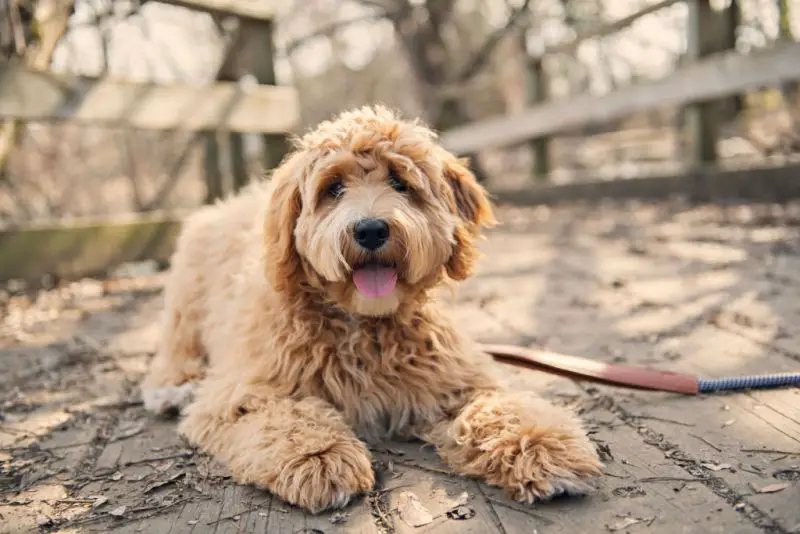
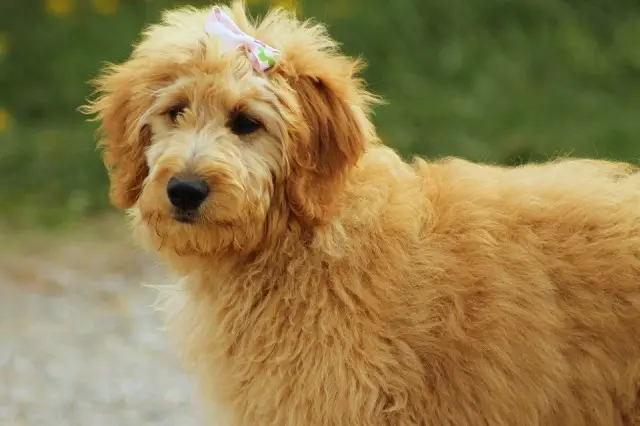
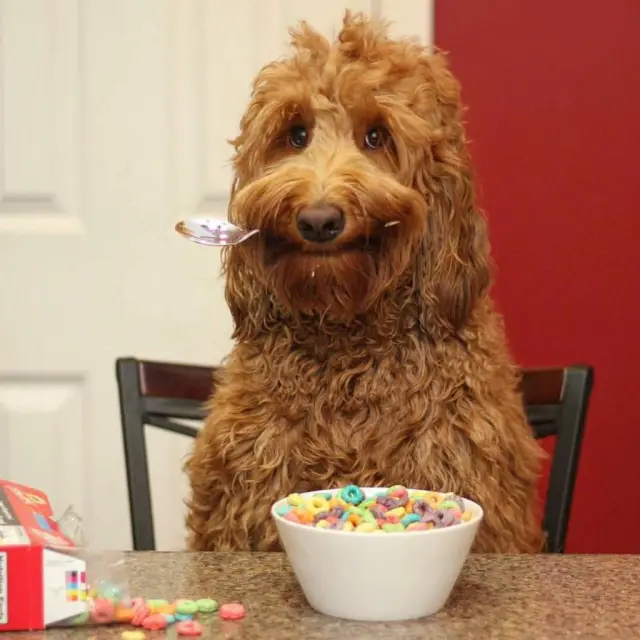
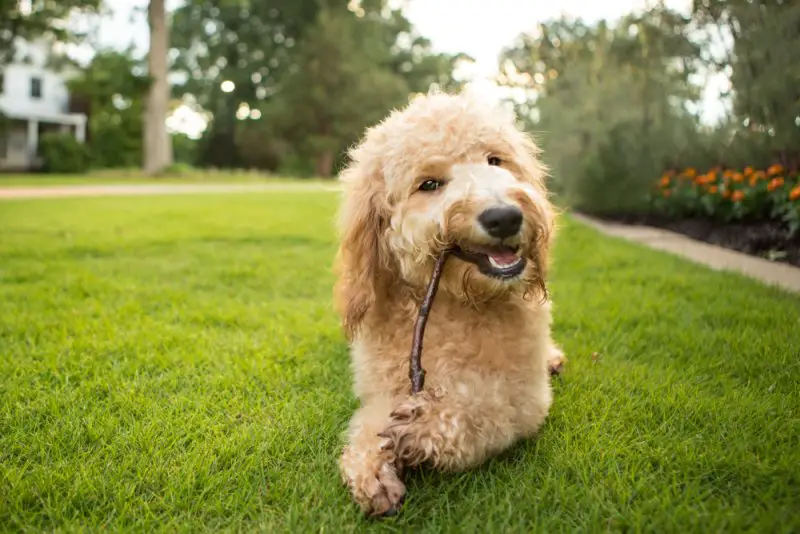
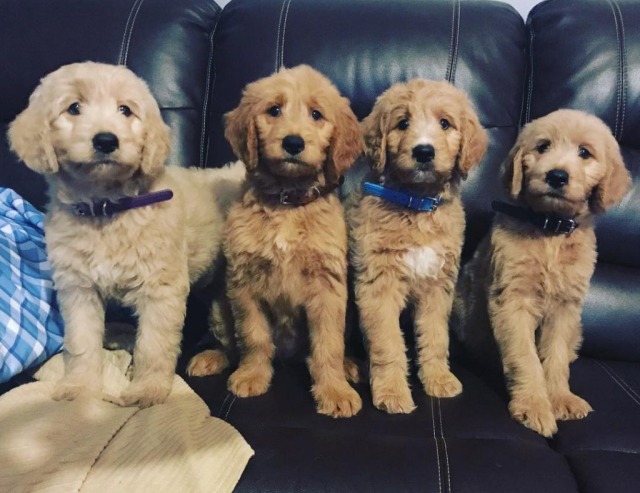
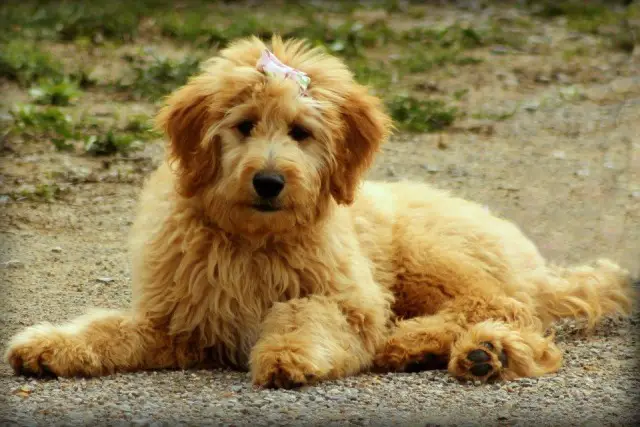
What a cute Goldendoodle with a bow on her head! Adorable